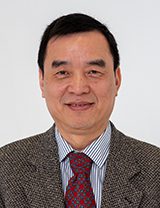Welcome From The Chair
Riqiang Yan, PhD

The Department of Neuroscience has a rich history of research excellence since it had been formally established by Dr. Richard Mains in the year 2000. Currently, we have 26 faculty members, who are actively funded their research from various sources including the federal grants and philanthropic support. Our faculty and their laboratories utilize an interdisciplinary approach to research with the goal of understanding the normal function and disorders of the nervous system that may hold the key to developing novel therapies. We nurture an exceptionally collegial academic environment with high level of interaction and collaboration among laboratories in the Department and with other laboratories at UConn Health Center and at the UConn Storrs campus, all of which make the Department of Neuroscience a vibrant and dynamic place to do science. We also have many jointly appointed faculty and Neuroscience Program faculty, who conduct their research in the broader Neurodevelopmental and Neurological diseases areas and contribute to many of our collaborative researches. Along with research, education continues to be an equally important responsibility for our faculty who are dedicated to teach and equip our graduate, medical and dental students with the most updated knowledge. Our neuroscience training program aims to prepare the upcoming generation of scientists for the next several decades of their careers furthering their independent research at major institutions around the world, to become industry leaders or critical thinkers in various career choices.
We welcome you to visit the Department of Neuroscience virtually or in person. Feel free to contact any of us by email or telephone for additional information.
What We Want Our Trainees to Learn
To appreciate and contribute to the important discoveries of the past few decades, from the earliest anatomical mapping to the latest gene cloning, scientists in the field of neuroscience need to have both a broad understanding of the historical background of the field, and what the key questions are today, where the field is going, and the key methodologies to reach the future goals. The goal of good neuroscience training is to prepare scientists for the next several decades of their careers, a truly daunting task.
The nervous system has laid down many hurdles for us, as if to make the task more fun and challenging: there are easily hundreds of cell types in the nervous system, more than in any other tissue; many neurons live for roughly the lifetime of the organism, again unlike most other tissues; and the functions of neurons can change dramatically over the lifespan of the organism.
Over the next few decades, a number of experimental preparation approaches will be very important, and we want our students to be ready to use these approaches and, more importantly, the as-yet-to-be-invented methods, and to have the knowledge needed to develop the next generation of approaches. With knowledge of their genomes complete, studies on C. elegans and Drosophila will reach a new level. Bioinformatics will be a key research tool available to all who have the skills to access the information. Mice expressing transgenes of interest and engineered for tissue-specific expression or lack or expression of specific genes will be essential tools. Proper use of these mice will require a variety of experimental approaches, ranging from behavioral to biochemical to anatomical and electrophysiological. Insight gained from crystallographic studies of key proteins will allow neuroscientists to probe specific protein-protein interactions in the proper cellular context and facilitate design of pharmaceutical compounds. New disease models will take us closer to studying human pathology and non-invasive methods and well-defined test questions will allow us to study humans as test subjects. Noninvasive optical methods will allow information to be gained about population averages of neurons in a way heretofore impossible. The critical, exciting, key experimental questions of today will merit intense discussion and investigation.
For our students, the ability to identify the critical questions of the future is essential. A broad background of knowledge, and a willingness to appreciate the insights gained from many different approaches, are key to this ability. These are attitudes that students acquire, almost unknowingly, from the faculty around them. Our faculty are excited about their own work. They are also interested in the work of their colleagues. They respect the contributions that can be made by psychophysicists, X-ray crystallographers, electrophysiologists, molecular biologists and anatomists and know that progress on the big questions requires the patient cooperation of outstanding researchers with diverse areas of expertise. Probably the key ingredient here is respect for contributions that come from the different approaches and a commitment to spanning the gaps between these seemingly disparate worlds.